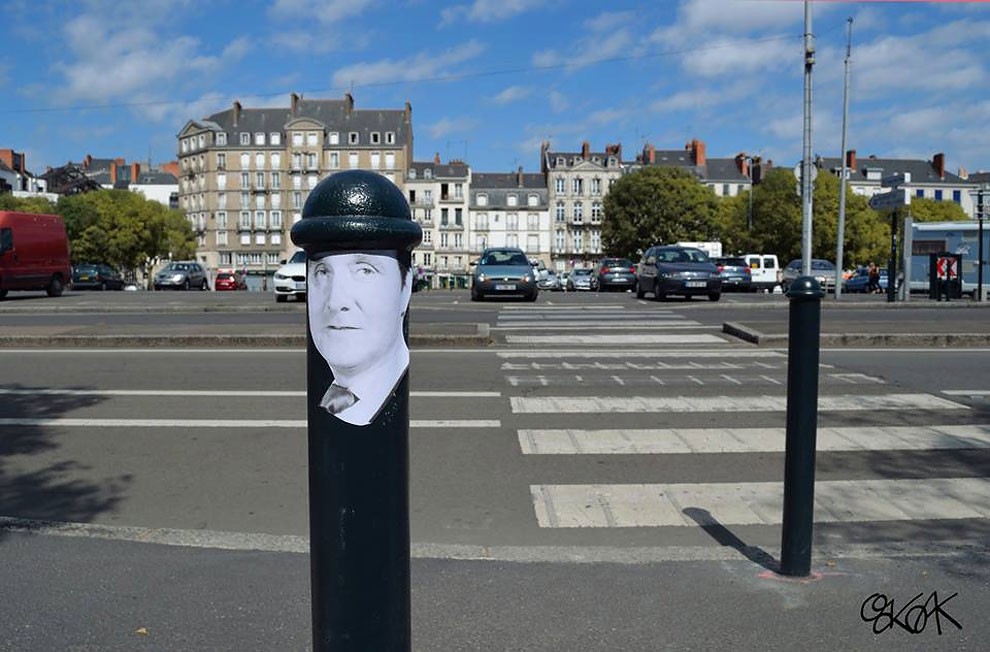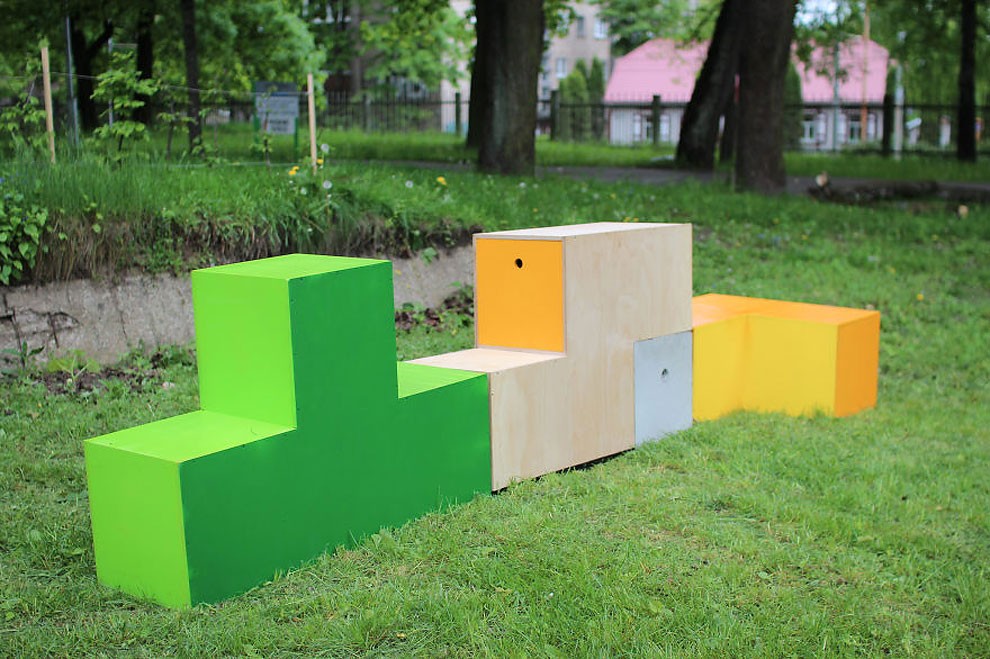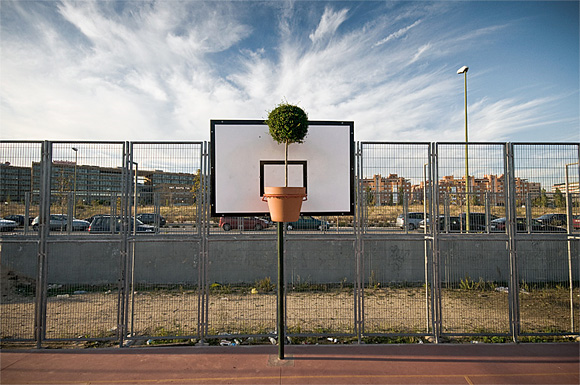Urban Diversion: Playful Street Art Interventions on the Streets of France

Street artist OakOak continues to bring smiles and double-takes to his hometown of St. Etienne, France, an old industrial town with drab facades and cracked sidewalks ripe for his unique brand of visual jokes. Continue reading »
Urban Interventions By Sath
Mallorca (Spain). Sath opened his eyes for the first time in 1983. After several years as an autodidact painter, in 2004 he enrols on Graduate Diploma in Graphic Design in the city of Palma.
Sath uses figurative elements to create colorful pieces slightly surreal, and impossible situations or actions, but never neglecting the message. Everyday life situations melt and transform into new ones, implying a change of meaning from its original context. He pursues the idea of the re-contextualization as a tool to construct new meanings.
Using spray painting as his main coloring technique since 2002, this visual communicator shares his curiosity and thoughts through painting art, either on canvas or making a different use of urban environment mainly outside of the context of traditional art venues.

Bynary system – Mallorca (Spain, 2013)
Continue reading »
Tetris Inspired Urban Furniture Turns Public Spaces Into Playgrounds

Open Code Urban Furniture – a construction set adaptive to the needs and wishes of different neighbourhoods. Instrumental in arranging a space for sharing (drawers installed). A series of open code urban furniture workshops are run in 4 Vilnius neighbourhoods in cooperation with the local residents. 4 furniture sets, 4 Vilnius neighbourhoods – and 4 different scenarios of use, to understand how public spaces and urban furniture work. The same basic set becomes different in each context. Continue reading »
Inside the Abandoned Belgium Mansion with the Urban Explorer Andre Govia
The beds are made up, but this abandoned mansion has not had an occupant sleeping in its grand rooms for years. The tenants at the Round Mansion in western Belgium are long gone, but the bedrooms are still occupied by expensive furniture and ornaments. These serie photographs were captured by London urban explorer Andre Govia, after he decided to start documenting his love of abandoned buildings.

With an abandoned tricycle sitting in an empty corridor, this derelict but once grand mansion could be the setting for The Shining. Continue reading »
Thousands of Caimans Thrive in Rio’s Urban Sprawl

In this October 14, 2013 photo, ecology professor Ricardo Freitas releases a broad-snouted caiman after examining it, at the Marapendi Lagoon in Rio de Janeiro, Brazil. Some 5,000 to 6,000 broad-snouted caimans live in fetid lagoon systems of western Rio de Janeiro, conservationists say, and there’s a chance that spectators and athletes at the 2016 Olympics could have an encounter with one, though experts hasten to add that the caimans, smaller and less aggressive than alligators or crocodiles, are not considered a threat to humans. (Photo by Felipe Dana/AP Photo) Continue reading »
Urban Explorer Bradley Garrett
These photographs are the work of urban explorer Dr Bradley Garrett who made headlines back in 2012 when he posted a series of snaps from the top of The Shard skyscraper while it was still under construction. Garrett, now a researcher at the University of Oxford, took these shots during his time with the London Consolidation Crew (LCC), a loose collection of urban explorers based in the English capital.

A hooded figures sits in a crane cab high above the city on the site of The Shard skyscraper in London. (Photo by Bradley L. Garrett/Barcroft Media) Continue reading »
Bodies in Urban Spaces
“Bodies in urban spaces” is a temporarily intervention in diversified urban architectonical environment. The intention of “bodies in urban spaces” is to point out the urban functional structure and to uncover the restricted movement possibilities and behavior as well as rules and limitations.
By placing the bodies in selected spots the interventions provoke a thinking process and produce irritation. Passers by, residents and audience are motivated and prompted to reflect their urban surrounding and there own movement behavior and habits. “Bodies in urban spaces” invites the residents to walk their own city thus establishing a stronger relationship to their neighborhood, district and town. The interventions are temporarily without leaving any traces behind, but imprints in the eye-witnesses` memory.
“Bodies in urban spaces” is a moving trail, choreographed for a group of dancers. The performers lead the audience through selected parts of public and semi-public spaces. A chain of physical interventions set up very quickly and only existing temporarily, allows the viewer to perceive the same space or place in a new and different way – on the run. The special quality of each place at various times of the day creates unique presentations. Photos: “Bodies in Urban Spaces”, September 26, 2010. (Photos by Andrew Russeth) Continue reading »
Urban Fox by Ian Wade
“I have been photographing this group of urban foxes in Bristol for over 12 months; what started off as a chance encounter has become an obsession for me and has changed my feelings and attitudes towards urban foxes forever. Over this 12 month period, I have talked on BBC Radio Bristol twice,worked with Spring Watch TV show and published my first book title Bristol Safari – In Search of City’s Urban Wildlife and have met people who generally care about these animals, together with people who hate them with a passion. I have even been threatened in the street for photographing these animals, which shows feelings towards are mixed at the best of times. I couldn’t help but become attached to these beautiful animals which I have now watched for hundreds of hours”. – Ian Wade. Continue reading »
The Urban Greenhouse
Designed by art students Audrey Charré, Clémentine Schmidt and Luc Beaussart, the ‘Urban Greenhouse’ wants to show and give value to the plants which grow by themselves in a city. Those discredit plants are, in fact, healthy, médicinal and sometimes eatable. The first part of the project was to give value by a three-dimensional graphic intervention. The other part of the project was to use those plants like a kind of material to make leaf mould. The organic waste become a strong productive material. The relevance of this project is to see what is already here in the city, to find a purpose to create a cycle from the city. Continue reading »
SpY. Urban Arts.

SpY is an artist from Madrid. His first actions appeared in the middle eighties. Continue reading »




